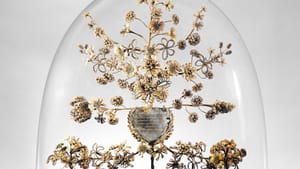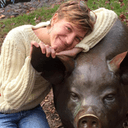Stay in the Loop
BSR publishes on a weekly schedule, with an email newsletter every Wednesday and Thursday morning. There’s no paywall, and subscribing is always free.
The fibers of our being
Mütter Museum presents 'Woven Strands: The Art of Human Hair Work'

As Women’s History Month passes its midway point, it’s worth considering some of the more arcane manifestations of women’s artwork. One example is the Mütter Museum’s latest exhibit, Woven Strands: The Art of Human Hair Work. The result of a recent collaboration between the Mütter and Brooklyn’s Morbid Anatomy Museum, Woven Strands takes a fascinating look back at the art of Victorian hair work and features a well-curated collection of jewelry, wreaths, dioramas, and scenes of mourning made from human hair.
Offering museumgoers a unique opportunity to view intimate memorials and works of art rarely put on public display, the exhibit also provides a thoughtful counterpoint to the (often male-centered) history of morbid medicine on permanent display at the Mütter.
More than shock value
At first glance it would be easy to take the collection of Victorian hair art at shock value, especially given the museum’s fondness for startling specimens and oddities. (One piece features an impressively framed mythology of the Montreal Ice Castle made from the artist’s own great-grandmother’s hair.) Yet it quickly becomes clear that Victorian hair work is much more than mere oddity; rather, it was an intensely time-consuming practice used by many women to weave deeply personal mementos into a complex narrative of love, loss, and devotion.
This emotional and technical depth is clearly captured in one of the exhibit’s grander pieces, a 19th-century wreath woven by Amy Ida Williams containing locks from 53 different origins. The wreath itself is a dense, gimp-work horseshoe opening upward to embrace a smaller knot of woven flowers, which are in turn topped by a smaller horseshoe bearing the inscription “AIW 1882.”
It’s an impressive piece of work; the wreath is composed of minute twists of wire that blend sepia-tone shades of auburn, blonde, chestnut, and ashen hair into a profusion of tiny flowers and intricate loops, and it is a powerful testament to Williams’s skill and patience as a craftswoman.
Other pieces are much simpler. “Pair of Framed Children’s Memorials” are two 19th-century palette work memorials for Priscilla and Aquila Shaw, both two years old at the time of their deaths. Palette hair work consists of a sheet-like application of single strands which are then cut into various forms and overlaid on paper to create a painting-like scene. In Priscilla’s case, the image features a lonely hilltop headstone shadowed by a solitary willow, whose branches splay above like the fringe of bangs against a young child’s forehead.

Hair art and artifact
Such scenes of grief are characteristic of hair art, practiced since the medieval period, when wealthy families gave locks of hair as keepsakes to funeral mourners. The form gained renewed popularity under Queen Victoria, however, who commenced a 40-year mourning period upon the death of her beloved Prince Albert in 1861. The fashion for memorial hair jewelry soon spread throughout Europe.
American hair work, however, experienced a marked growth in popularity after the end of the Civil War in 1865. Hair was kept both in and as jewelry in memory of friends and distant loved ones. One particular example of tablework hair jewelry includes a delicate chestnut-colored bracelet with a Civil War kepi (military hat) charm, just large enough to fit around a slim wrist.
This example—and several other examples of American Civil War-era hair work—add a beautifully understated counterpoint to some of the Mütter’s ongoing exhibits, which tend to focus on early, male-dominated conceptions of medicine and medical practice; Broken Bodies, Suffering Spirits features a grisly catalog of Civil War battlefield wounds and medical procedures, ostensibly interspersed for sentimental effect with grandiloquent quotes by Walt Whitman. In Woven Strands, however, the exhibit draws its sentimental force from the very devotion, patience, and skill of those whose art it features.
Though Victorian hair work was admired in its day as a form of women’s fancy work, Woven Strands now gives visitors the opportunity to publically appreciate this art form accompanied by helpful descriptions of its history and technique. For those interested, the Mütter Museum will also be holding a Woven Strands hair art symposium on April 8, featuring discussion by collectors, artists, and historians, followed by a post-event reception. Tickets for both events are available at the museum’s website.
What, When, Where
Woven Strands: The Art of Human Hair Work. Through September 16, 2018, at the Mütter Museum's Thomson Gallery, 19 S. 22nd Street, Philadelphia. (215) 560-8564 or muttermuseum.org.
Sign up for our newsletter
All of the week's new articles, all in one place. Sign up for the free weekly BSR newsletters, and don't miss a conversation.

 Helen Walsh
Helen Walsh